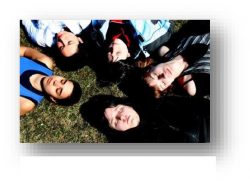
Picture 1: PLYA from Novo Mesto
Project Learning for Young Adults (PLYA) is a non-formal educational program from Slovenia with defined scopes and goals. The program is designed to help young dropouts take creative and active part in social and working life, it enables them to discover their interests and talents, motivates them to return to school, and it also equips them to be more competitive in the labour market and thus increase their employability.
Through individual work, project work and various activities of interest, youngsters gain motivation, self-independence, new skills for life and work, working habits that encompass well-being and employability.

Picture 2: PLYA from Radovljica – The right to
The core goals of the PLYA program as a holistic approach are the educational and social integration of young people. The project methodology consists of a highly flexible learning curriculum, which leans on detailing the familiarity of the teacher with the social and psychosocial context and/or situations of the learners. When youngsters need some other professional help, mentors help them to get such help. Young people are treated as individuals and their individual life situation is entirely taken into account. The programme’s effects significantly depend on those who carry it out, that is – on the mentors. The evaluation group attributes the quality of implementation to the following factors: the mentors must, besides the required basic education, undergo training within a more extensive programme, which helps them familiarise with the social and psychosocial causes and characteristics of dropouts, modern curricular principles and implementation, as well as with initial assessment.
The clear structure of the day and the basic rules of the programme help young dropouts meaningfully organise their learning and social activities throughout the day. This is important, because after they left school, their whole life was torn apart and they had no goals or structure. Because more activities and programmes run at the same time, youngsters can be included in PLYA and also do exams in the school, attend lessons in the school or follow other activities.
As a basic project work, its most important characteristic is sensibility to the interests and abilities of participants who also participate in planning the work. Participants choose a theme for the project, learning sources, methods and procedures, while mentors help them in doing so. Because of the fact that participants actively participate and make decisions about the programme’s implementation, their motivation for participating in the programme increases, and thus also their motivation to learn and continue their education.
An important part of an individual approach is where the mentor and the participant together create the individual plan for the participant, which is being realised during the programme. This plan is the foundation for all his or her activities in the programme. The individual plan is a plan of the participant’s progress in all fields, not only those pertaining to schooling but also in the social, motivational and personal field. It represents the basis on which all project activities in the programme are chosen, since the rationale for these activities are the goals set by the participants.
